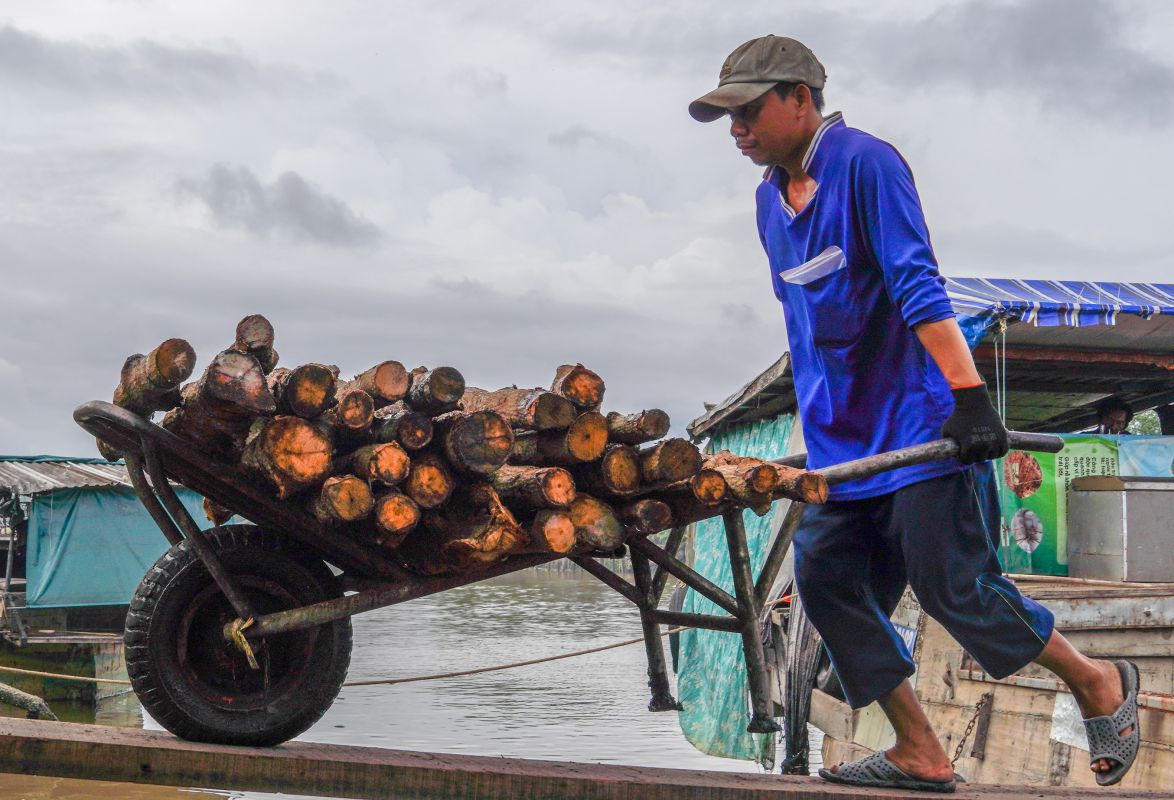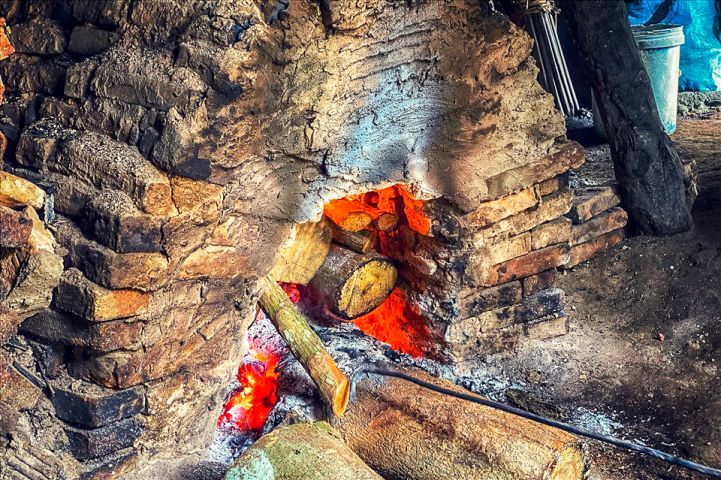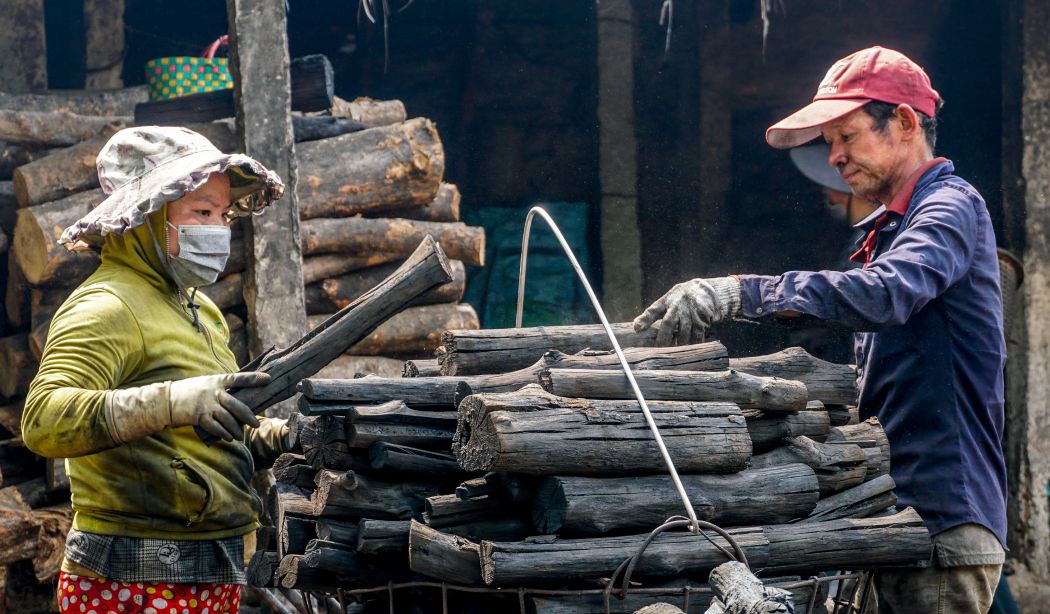The coal kilns by the river
In the last days of 2024, Lao Dong Newspaper reporters made a trip to Xuan Hoa coal village (Ke Sach district, Soc Trang province). Traveling along provincial road 932B through the coal mining village, we could smell the distinctive smell of firewood. Below the banks of Cai Cui and Kinh rivers, many boats were loaded with firewood, many workers were urgently bringing it ashore; others were transporting coal from the shore to the boats to sell to traders... the atmosphere was extremely bustling.
Mr. Nguyen Truong Giang - Vice Chairman of Xuan Hoa Commune People's Committee - informed that this is one of the large and long-standing charcoal production villages in the West. The village was formed over 50 years ago. In 2008, it was recognized as a traditional village by the Soc Trang Provincial People's Committee. Currently, there are over 200 households working with over 400 kilns in operation.
We visited the family of Mrs. Nguyen Thi Muoi - a household that has been in the profession for nearly 30 years in Xuan Hoa commune - right at the time of preparing a new batch of coal.
“The charcoal making business has been around for a long time, almost every family does it. My brothers and I each have 5-6 charcoal kilns. On average, each kiln makes a profit of 10-15 million VND. If the price is not good, it is at least 5-6 million VND per kiln,” said Mrs. Muoi.
Pointing to the furnace door, Ms. Nguyen Thi Muoi said that after filling the furnace with firewood, the furnace door will be sealed and a fire will be started for 20-30 days. During that time, the fire must be continuously lit to create heat so that the firewood can slowly turn into coal. When the coal is cooked, the furnace door and chimney will be sealed to prevent air from entering. After 15-20 days, when the temperature has decreased, the coal will be taken out of the furnace. "The fire-tending process is very important, the fire must be kept stable, if it goes out, the coal is not of good quality. For about a month, we must always be on duty to tend the fire regardless of day or night," Ms. Muoi said.
Mr. Dinh Van Nam - a charcoal kiln owner in Xuan Hoa charcoal village - said that the main raw materials used to make charcoal are mangrove trees purchased from Ca Mau, in addition to longan, star apple, eucalyptus, grapefruit, etc. On average, each year, a charcoal kiln produces 6 batches, each batch averaging 12 tons. Depending on the size of the kiln, firewood is added accordingly. Usually, from 80 to 100 xi of firewood (1 xi = 1m3), each xi costs 1.3 to 1.5 million VND. The total cost of firewood for a kiln is from 60 to 75 million VND, not including labor costs. Mr. Le Van Khiem - a charcoal kiln owner in Xuan Hoa - added that because the kiln takes more than half a month to produce a batch of charcoal, it is called a charcoal kiln. The consumption market is mainly domestic and partly exported.
Where there is dust, there is money.
In addition to providing income for the kiln owners, Xuan Hoa coal industry also creates jobs for over 1,000 local workers with jobs such as carrying, bringing firewood into the kiln, loading, sorting coal, transporting it to boats or trucks. During the main season, workers earn between 300,000 and 400,000 VND/day.
Just pushing a cart of about 50kg of coal out of the furnace, her face black with dust, Ms. Dang Thuy Van said that she has been in this profession for more than 20 years. Her daily job is to carry firewood into the furnace to burn it and then carry the coal out. "My husband and son also participate in carrying coal here. The furnace owner calculates the salary by ton - each ton of coal is 160,000 VND. That means the daily income is from 250,000 - 300,000 VND/person," Ms. Van said.
Mrs. Bui Duyen is probably the oldest worker in Xuan Hoa coal village. She is 66 years old this year and has been working in the coal industry for over 40 years. Despite her advanced age, her hands and feet are still agile. Every day she goes to the furnaces to scoop up dust and coal fragments. “For the past ten years, every day I go to the furnace at 7am and come back at 2-3pm. My daily income is 200,000 VND. Living alone, sometimes I have a little extra,” Mrs. Duyen said with a smile.




The black houses in the hamlet
Although providing jobs and stable income for people, the coal kilns in Xuan Hoa have caused many consequences from smoke and dust. Traveling along Provincial Road 932B through the coal kiln craft village in Xuan Hoa commune, it is easy to see trees, houses, fences, traffic signs... all covered in black smoke. A household living next to the coal kiln village said that people here do not think about painting or repairing new houses because in just a short time, the walls of the house are as black as ink.
In the coal kilns, many workers were hurriedly carrying firewood into the furnace, while others were unloading coal from the furnace to sort it. Their faces were dirty and their clothes were covered with dust. Most of these people only wore hats, using cloth to cover half of their faces to keep the dust from getting into their noses, and their eyes were still unprotected by glasses.
Pointing at the pile of coal that had just been taken out of the furnace, Ms. Ta Thi Lon said that this job is very hard. You have to stay in the furnace full of dust and lack of light, even though you cover your nose, the dust still flies in. "Usually, after the coal is cooked, it will be left to cool for about 15 days before being taken out, but sometimes because of the high demand, the furnace owner is in a hurry to sell, I have to go in and get it, so sometimes the coal is still hot, sometimes my hands are blistered and bleeding," Ms. Lon said.
Ms. Bui Duyen added that the hot months combined with the heat in the furnace made her unbearable, so she had to go down to the river to cool off before continuing. “This job is hard and dusty, but if I didn’t do it, how would I make a living?” Ms. Quyen said.
Find technological solutions to reduce pollution
Mr. Nguyen Truong Giang - Vice Chairman of Xuan Hoa Commune People's Committee - shared that recently, relevant departments and branches have implemented many measures to treat emissions from coal-fired kilns suitable for household scale. However, the cost of a treatment system is still quite expensive compared to the income from coal-fired kilns, so people are not interested. "Currently, only one household is implementing this model" - Mr. Giang said.
Mr. Nguyen Van Chuyen - owner of 7 coal kilns in Xuan Hoa coal village - said that a few years ago, the facility used a smoke collection and misting system to reduce dust and smoke, but the amount of CO gas was still high.
“I hope to receive support for investment in new and effective technology to improve product quality and reduce environmental pollution for long-term development,” said Mr. Chuyen.
Mr. Nguyen Thanh Duy - Director of the Department of Science and Technology of Soc Trang province - informed that last August, a working group of the Ministry of Science and Technology visited the craft village to survey the current situation, record opinions and recommendations from people directly involved in production as well as people living in the area. The Department of Science and Technology also proposed to support the locality in researching smoke and dust treatment equipment; have policies to support kiln owners with funding to install equipment to ensure no pollution. At the same time, it is necessary to have solutions to support the production process, in order to shorten the time to create fast and quality products, contributing to increasing higher income for people.
“The Vietnam - Korea Institute of Science and Technology has also proposed selecting a number of pilot households to use the circulating heat source for coal production to reduce CO emissions, save costs, and thereby reduce environmental pollution,” Mr. Duy informed.
(Posted on the special edition of Labor Weekend Spring At Ty)










